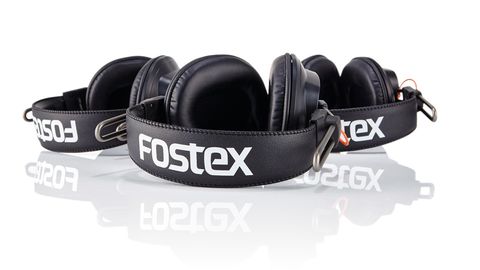The RP suffix refers to the patented Regulated Phase technology, which couples a copper foil etched polyimide film diaphragm with a neodymium magnet driver.
The former apparently offers improvements over traditional materials with increased flexibility and durability to handle high pressure levels, while the latter is a regular component for modern high sensitivity transducers, as it is capable of articulating transient information with great accuracy (this is due to a high mass to magnetic field strength ratio).
The mk3 T-RP range is based on a solid design, weighing in at just over a pair of Beyerdynamic DT770s. The wide headband is adjusted via sturdy metal rails and the padding is finished with a soft (faux?) leather.
All three models are supplied with two cords for single sided connection: a 3m straight black cord (6.3mm jack), and a 1.2m straight orange cord (3.5mm jack) for mobile usage. Both are secured to the headphones with a simple twist-lock.
The enclosures are of the supra-aural type, which can prove fatiguing when pressed against the ears on long sessions, though we did not find this effect as much as we expected.
- Best studio headphones: top headphones for music production
"As ever this is a subjective quality, especially as the actual response is smooth, and this is nowhere more apparent than in the mids where these headphones come into their own."
The three models differ in transducer housing type: open back (T20), closed back (T40) and semi-open back (T50). This can be seen via the grille slats on the outside of the ear enclosures, which for the T20s and T50s reveals varying thicknesses of foam lining, while for the T40s the slats haven't been cut through the plastic moulding.
Three of a kind
Common to all is a clear yet soft high-frequency response. They are by no means bright, which on the positive side leaves them free from harsh top-end hype.
At first we found them a tad dull, or soft, but over time we became used to this characteristic and was impressed with the coherency of the high-frequency range which appears free of audible resonant peaks/troughs.
We missed a bit of airiness, finding it harder to push/pull in a mix than usual, and found some high sibilance or noise components were harder to spot than on my studio monitors, but conversely this did help them feel less fatiguing in use.
As ever this is a subjective quality, especially as the actual response is smooth, and this is nowhere more apparent than in the mids where these headphones come into their own.
We don't have a bad word to say about the mid and low mid characteristics of the T-RP mk3s as the articulation is excellent. This is great for tracking/ mixing as dialling in EQ, judging mic distance and pushing saturation/ distortion, to name but a few tasks, are made quick and easy. Subtle changes are free from the masking effects of poor frequency/phase response in this critical frequency range.
The major difference between the models results from the three enclosure topologies (open, closed, semi-open), and this is mostly focused on the low-end, which is where we found our (least) favourite model.
The semi-open back T50s are the best balanced of the three with regard to the bass range. The low frequencies come through clear and dynamic without dominating or masking the low mids.
"The RP drivers give these models high headroom and we can attest to their lack of audible distortion at high gain, though we have now vowed to never turn headphones up that loud again!"
The closed back T40s were surprisingly non-resonant or boomy, which is often a by-product of the 'trapped' low-end, and though the bass is all there, they do seem limited in comparison to the T50s; flappy kick drums and bass synth decays disappear out of view a little quicker on the T40s. The open back T20s go the opposite way, sounding overly dominant in the bottom octaves, which then tends to mask the low mids and accentuate the soft high-end, and such a voicing made them hard for me to trust in a mix. Again, this is a subjective response.
Stereo imaging for headphones has a lot to do with damping enclosure suspension vibrations to keep the two sides as physically independent as possible, but it is also reliant on clarity within our key aural sensitivity ranges.
The quality of mid-range reproduction in the T-RPs helps create a very natural stereo image and, though the HF region is not as forward as is common, this doesn't affect the sense of space.
The RP drivers give these models high headroom and we can attest to their lack of audible distortion at high gain, though we have now vowed to never turn headphones up that loud again!
We wouldn't advise cranking up headphones, but these will cut through in a loud environment, and that softer high-end makes much more sense up at such levels.
The only drawback is that the supra-aural design makes them less effective at isolating the listener from external sound sources than a circumaural design. The 500 input impedance does mean to get them right up there you will need an amp with plenty of power.
The T-RP range has real quality with its mid-range clarity and high input headroom, making them useful for engineers, performers and DJs. The high-frequency response is smooth and unusually un-forward, setting them apart from many brash sounding headphones that can be found at this price.
Whether this is a good thing is a purely subjective matter, and one we have shifted on having spent time with these headphones. We definitely recommend checking out the T40 and T50 models, with the latter being the standout.


